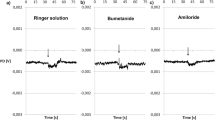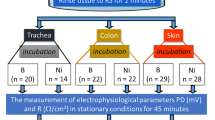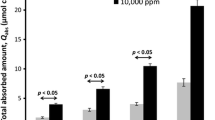Summary
The importance of a mucus layer in the transepithelial movement of ions was examined in frogs by altering the surface charge density while measuring22Na and36Cl fluxes. Cationic dyes such as Alcian Blue and Ruthenium Red titrate surface mucus but did not affect22Na or36Cl influx or efflux. Other agents such as lanthanum, Azure II, calcium and arginine titrate the subcorni-fied space mucus yet did not affect22Na movement through this action. Thus, the mucus layer does not play a role in epithelial sodium or chloride movement across frog skin.
Similar content being viewed by others
References
Allen A (1978) Structure of gastrointestinal mucus glycoproteins and the viscous and gel-forming properties of mucus. Br Med Bull 34:28–33
Alvarado R, Poole A, Mullen T (1975) Chloride balance inRana pipiens. Am J Physiol 229:861–868
Bentley P, Jorio T (1979) Do frogs drink? J Exp Biol 79:41–46
Biber T, Chez R, Curran P (1966) Sodium transport across frog skin at low external sodium concentration. J Gen Physiol 49:1161
Biber T, Cruz L, Curran P (1972) Sodium influx at the outer surface of frog skin. Evaluation of different extracellular markers. J Memb Biol 7:365–376
Blanc-Livni N, Abraham M (1970) The influence of environmental salinity of the prolactin- and gonadotropin-secreting regions in the pituitary ofMugil (Teleostei). Gen Comp Endocrinol 14:184–197
Burden C (1956) The failure of hypophysectomizedFundulus heteroclitus to survive in fresh water. Biol Bull 110:8–28
Curran P, Gill T (1962) The effect of calcium on sodium transport by the frog skin. J Gen Physiol 45:625–641
Ferreira K, Hill B (1978) Chloride dependence of active sodium transport in frog skin: The role of intercellular spaces. J Physiol 283:293–305
Greenwald L (1971) Sodium balance in the leopard frog (Rana pipiens). Physiol Zool 44:149–161
Helferrich F (1962) Ion exchange. McGraw Hill Co, Inc, New York
Hillyard S, Gonick H (1976) Effects of Cd++ on short-circuit current across epithelial membranes. I. Interactions with Ca++ and vasopressin on frog skin. J Memb Biol 26:109–119
Jozuka K (1966) Chloride-excreting and mucus-secreting cells in the gills of the Japanese common eel,Anguilla japonica. Annot Zool Jpn 39:202–208
Kirschner L (1982) NaCl transport of intact frogs and isolated frog skins: a reconcilation. In: R Corradino (ed) Physiology: the next decade. Elsevier, New York, pp 199–215
Kirschner L, Greenwald L, Kerstetter T (1973) Effect of amiloride on sodium transport across body surfaces of freshwater animals. Am J Physiol 224:832–837
Lemoine A-M, Olivereau M (1973) Action de la prolactine chez l'anguille intacte et hypophysectomisée: IX Effect sur la teneur en acide-N-acetylneuraminique de la peau en eau de mer. Acta Zool 54:223–228
Manning G (1969) Counterion condensation. J Chem Physiol 51:924–933
Marshall W (1977) The functions and endocrine control of epithelial mucus secretion in the family Cottidae. Thesis, University of British Columbia
Martinez-Palomo A, Erlij D, Bracho H (1971) Localization of permeability barriers in the frog skin epithelium. J Cell Biol 50:277–287
Mattheij J, Sprangers J (1969) The site of prolactin secretion in the adenohypophysis of the stenohaline teleostAnoptichtheys jordani, and the effects of this hormone on mucous cells. Z Zellforsch 99:411–419
Meyer F, King M, Gelman R (1979) On the role of sialic acid in the rheological properties of mucus. Biochim Biophys Acta 392:223–232
Pearse A (1968) Histochemistry: theoretical and applied, vol I, 3rd edn. Little, Brown and Co, Boston
Preston B, Snowden J (1972) Model connective tissue systems: the effect of proteoglycans on the diffusional behavior of small nonelectrolytes and microions. Biophys J 11:1627–1643
Raffy A (1950) Reactions deGobius paganellus à la dessalure. CR Soc Biol 144:1649–1651
Scott J, Willett J (1966) Binding of cationic dyes to nucleic acids and other biological polyanions Nature 209:985–987
Solomon C, Cotton E, Dubois R, Pinney M (1971) The use of bufferedl-arginine in the treatment of cystic fibrosis. Pediatrics 47:384–390
Stith B (1984) Biochemical examination ofRana pipiens epithelial mucus. J Comp Physiol B 155:89–96
Teorell T (1953) Transport processes and electrical phenomena in ionic membranes. Progr Biophys Biophys Chem 3:305–369
Thurman C, Higgins J (1982) Amiloride stimulation of sodium transport in the presence of calcium and a divalent cation chelator. Biochim Biophys Acta 689:561–566
Ussing H, Zerahn K (1951) Active transport of sodium as the source of electric current in the short circuited isolated frog skin. Acta Physiol Scand 23:110–127
Whitear M (1977) A functional comparison between the epidermis of fish and of amphibians. Symp Zool Soc Lond 39:291–313
Author information
Authors and Affiliations
Rights and permissions
About this article
Cite this article
Stith, B.J. Effects of an external charged layer on transepithelial ion movement in frog skin. J Comp Physiol B 155, 97–101 (1984). https://doi.org/10.1007/BF00688797
Accepted:
Issue Date:
DOI: https://doi.org/10.1007/BF00688797




